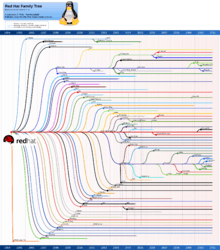Red Hat Enterprise Linux derivatives

Red Hat Enterprise Linux derivatives are Linux distributions that are based on the source code of Red Hat Enterprise Linux (RHEL).
History
Red Hat Linux was one of the first and most popular Linux distributions. This was largely because, while a paid-for supported version was available, a freely downloadable version was also available. Since the only difference between the paid-for option and the free option was support, a great number of people chose to use the free version.
Red Hat made the decision to split its Red Hat Linux product into two: Red Hat Enterprise Linux for customers who were willing to pay for it, and Fedora that was made available free of charge but gets updates for every release for approximately 13 months.
Fedora has its own beta cycle and has some issues fixed by contributors who include Red Hat staff. However, its quick and nonconservative release cycle means it might not be suitable for some users. Fedora is somewhat a test-bed for Red Hat, allowing them to beta test their new features before they get included in Red Hat Enterprise Linux. Since the release of Fedora, Red Hat has no longer made binary versions of its commercial product available free-of-charge.
Motivations
Red Hat does not make a compiled version of its Enterprise Linux product available for free download. However, as the license terms on which it is mostly based explicitly stipulate, Red Hat has made the entire source code available in RPM format via their network of servers. The availability of the complete source code of the distribution in RPM format makes it relatively easy to recompile the entire distribution. Several distributions were created that took Red Hat's source code, recompiled it, and released it.
Features
The Red Hat Enterprise Linux derivatives generally include the union set, which is included in the different versions of RHEL. The version numbers are typically identical to the ones featured in RHEL; as such, the free versions maintain binary compatibility with the paid-for version, which means software intended for RHEL typically runs just as well on a free version. Relatively few changes need to be made to the distributions. However, RHEL used to use Red Hat's own Up2date technology for providing updates. For convenience, several of the free alternatives ship with yum replacing up2date, something that makes providing mirrors for upgrades significantly easier. Red Hat Enterprise Linux 5 and above releases use yum as their native system for providing updates, with up2date being just its front end.
Legal aspects
Free redistributions are expressly permitted by the GNU General Public License upon which Red Hat's distributions are based.[1] However, to avoid misrepresentation of Red Hat's trademark, material in the original distribution covered by the trademark must be stripped off or removed from the redistribution.
Where distributions (e.g., CentOS) have not been deemed sufficiently thorough in removing references to Red Hat, they have received warnings from Red Hat's legal counsel. CentOS received such a notice seeking to have it remove all mention of Red Hat's asserted trademarks from their website and their distribution.[2] CentOS previously referred to Red Hat as the "Upstream Vendor", or more formally as a "Prominent North American Enterprise Linux vendor".[3]
List of Red Hat Enterprise Linux derivatives
The following are listed by DistroWatch as being among the top 100 most popular distros (according to averaged daily search-counts on their website) for the past 12 months, as of December 2010, and verified again in September 2013:
- CentOS
- ROSA Enterprise Linux Server (first released in 2011; was not in the top 100 in 2010 but as of 2013 is second to CentOS)
- Scientific Linux
- ClearOS
- Oracle Linux - Requests registration, with personal information (name, email, company) and agreements, but does not require payment to download or deploy. Payment is required for support.[4]
Appliance-oriented derivatives based on RHEL:
- Google Search Appliance - derived from CentOS
- Cisco Unified Communications Manager[5]
- VMware ESX's Service Console software
- Amazon.com Amazon Linux AMI RHEL5/RHEL6 userland with a linux-xen-kernel
Lesser-known distros:
- Springdale (neé PUIAS) Linux, #161 on distrowatch as of 2013
- Rocks Cluster Distribution - derived from RHEL (earlier versions) and CentOS (recent releases), #186 on distrowatch as of 2013
- Fermi Linux, a.k.a. Fermi Scientific Linux, derived from Scientific Linux with additional software specific for the Fermilab research facilities, #231 on distrowatch as of 2013
- SME Server - derived from CentOS, #235 on distrowatch as of 2013
- CERN Linux, a.k.a. CERN Scientific Linux, derived from Scientific Linux with additional software specific for the CERN research facilities
- GENtOS Linux
- StartCom Enterprise Linux
- Bull's XBAS or bullx (for high-performance computing)[6][7]
- Ascendos
- Inspur K-UX, certified to The Open Group's UNIX 03 standard.[8]
Distros which have ceased production:
- Pie Box Enterprise Linux, no longer operating as of 2009-08-01
- Lineox
- TaoLinux - 4.0 i386 Final Release available on 2005-04-20; 3.0 Update 4 available on 2005-01-10, Ceased production on 2006-06-14. The web site includes instructions for updating to CentOS for continued updates
- X/OS Linux - Ceased production in 2008. The web site includes instructions for updating to CentOS for continued updates.
- CAOS Linux (multiple lineage)
- Yellow Dog Linux
- White Box Enterprise Linux - No formal announcement but no longer actively developed
See also
References
- ↑ http://readwrite.com/2013/08/13/red-hat-ceo-centos-open-source
- ↑ https://www.centos.org/modules/news/article.php?storyid=66
- ↑ http://www.centos.org
- ↑ https://blogs.oracle.com/wim/entry/reminder_oracle_enterprise_lin
- ↑ "Cisco Unified Communications Manager - Hardware, Software and Clustering". Retrieved 2009-02-05.
- ↑ SLURM at CEA
- ↑ http://news.bull.com/bulldirect/2010/11/10/bull-launches-bullx-supercomputer-suite/
- ↑ "The Open Brand Register of Certified Products". The Open Group. 2014-05-29. Retrieved 2014-05-29.